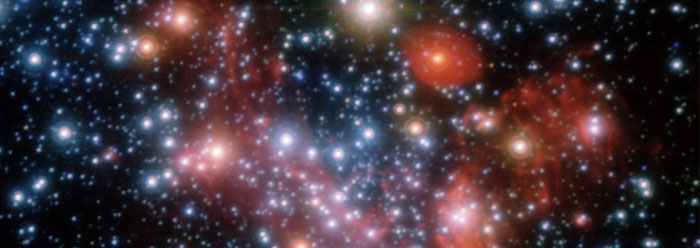German astronomers have been meticulously tracking the orbits of 28 stars nearest to the center of the Milky Way spiral galaxy. Over the 16 years of their study, one of the stars travelled so fast that it completed a full revolution. Though the galactic core is dark, its mass has been estimated based on the behavior of the stars that orbit it so closely. These observations seem to confirm that a black hole exists at the core of the Milky Way, but they also raise significant questions about the stars’ origins.
The European Southern Observatory (ESO) sponsored the study, which is slated to be published in the Astrophysical Journal.1 An ESO news release stated, “The mystery still remains as to how these young stars came to be in the orbits they are observed to be in today.”2 Given a purely naturalistic origin scenario such as that offered in the Big Bang theory, one wonders how so many stars and planets came to be in orbits at all, rather than swirling off into space.3 Even more curious is that the astronomers closely observed six of the stars inhabiting the same orbital pattern, like so many seats on a Ferris wheel. The question is complicated by the likely effects of the violent “forces of the black hole” that would rip stars apart, not place them on a galactic train track.
The ESO also stated, “Excitingly, future observations are already being planned to test several theoretical models that try to solve this riddle.”2 These models will certainly not include one that involves an outside intelligence having placed the stars in their orbits, even though other cosmologists have dedicated themselves to the search for alien intelligence, which some believe may have even seeded life on earth.4
The precise construction parameters of cosmic structures like these stars and the rules that govern them will only be intelligible as products of a supernatural Creator. Physicist Lee Smolen, after studying the myriad factors that make life possible in this world, said: “Luck will certainly not do here. We need a rational explanation why something this unlikely turned out to be the case.”5
References
- Gillessen, S. et al. 2008. Monitoring stellar orbits around the Massive Black Hole in the Galactic Center. Astrophysical Journal, in press.
- Unprecedented 16-Year Long Study Tracks Stars Orbiting Milky Way Black Hole. European Southern Observatory press release, December 10, 2008.
- Other unanswered questions in the Big Bang explanation of the origins of the Milky Way concern why the galaxy itself is spinning, why it still has distinct arms if it is really 13 billion years old, and why stars would form within the galaxy at all, when physics shows that the force from an exploding (pre-existing) star would be required to compress enough matter into a protostar. Though secular scientists’ anti-religious bias precludes them answering these questions with a “Who” instead of a “what,” there is no scientific reason to exclude the possibility that the galactic arms, motion, and stars were emplaced by a supernatural cause.
- Crick, F. and L. Orgel. 1973. Directed Panspermia. Icarus. 19: 341-346.
- Smolin, L. 1997. The Life of the Cosmos. New York: Oxford University Press, 24.
Image Credit: ESO/S. Gillessen et al.
* Mr. Thomas is Science Writer.
Article posted on December 17, 2008.





















